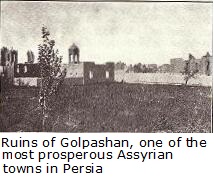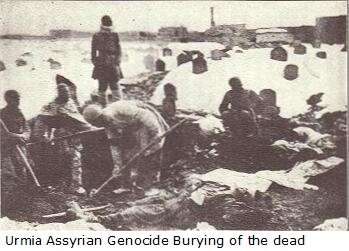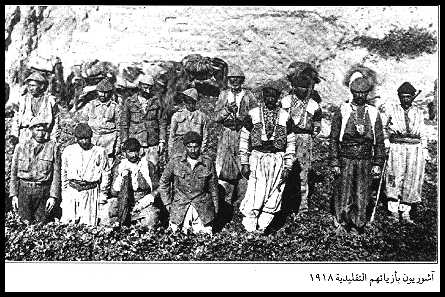The Assyrian Genocide
The Assyrian Genocide (also
known as Sayfo orSeyfo, Syriac: ܩܛܠܐ
ܕܥܡܐ ܣܘܪܝܝܐ or ܣܝܦܐ)
refers to the mass slaughter of the Assyrian population
of the Ottoman Empire during
the 1890s, the First
World War, and the period of 1922-1925. The
Assyrian population of upper Mesopotamia (the
Tur Abdin region,
the Hakkari, Van,
and Siirt
provinces of present-day southeastern Turkey,
and the Urmia region
of northwestern Iran)
was forcibly relocated and massacred by Ottoman
(Turkish) and Kurdish forces
between 1914 and 1920. Estimates on
the overall death toll have varied. Contemporary reports placed the figure at
250,000. Numerous scholars and
journalists have accepted that figure, though some sources lacking a detailed
statistical analysis claim figures as high as 750,000.
The Assyrian genocide took place in the same context as the Armenian and Pontic
Greek genocides.
In these events, close to three million Christians of Syriac, Armenian or
Greek Orthodox denomination were murdered by the Young
Turks regime.
Since the "Assyrian genocide" took place within the context of the much more
widespread Armenian genocide, scholarship treating it
as a separate event is scarce, with the exceptions of the works of David Gaunt
and Hannibal Travis.]In
2007, the International Association
of Genocide Scholars (IAGS) reached a
consensus that "the Ottoman campaign against Christian minorities of the Empire
between 1914 and 1923 constituted a genocide against Armenians, Assyrians, and
Pontian and Anatolian Greeks. The
IAGS referred to the work of Gaunt and Travis in passing this resolution.[6] Gregory
Stanton, the President of the IAGS in 2007-2008 and the founder of Genocide
Watch, endorsed the "repudiation by the world's leading genocide scholars of the
Turkish government's ninety-year denial of the Ottoman Empire's genocides
against its Christian populations, including Assyrians, Greeks, and Armenians."

Terminology
The Assyrian genocide is sometimes also referred to as Sayfoor Seyfo in
English language sources, based on the modern Assyrian (Mesopotamian
neo-Aramaic) designation Saypā(ܣܝܦܐ),
"sword", pronounced as Seyfo,
and as Sayfo in
theWestern dialect (the term
abbreviates shato d'sayfo "year
of the sword"). The Assyrian name Qeṭlā
ḏ-�Amā Āṯ�rāyā (ܩܛܠܐ
ܕܥܡܐ ܐܬܘܪܝܐ), which literally means "killing of the Assyrian people", is
used by some groups to describe these events. The wordQṭolcamo (ܩܛܠܥܡܐ)
which means Genocide is
also used in Assyrian diaspora media. The term used in Turkish media
isS�ryani Soykırımı.
In countries where significant Assyrian
diaspora communities exist, the
designation "Assyrian" has become controversial,
notably in Germany and Sweden,
alternative terms such asAssyriska/syrianska/kaldeiska folkmordet"Assyrian/Syriac/Chaldean
genocide" are employed. Nestorians, Syrians, Syriacs, and Chaldeans were names
imposed by Western missionaries such as the Catholics and Protestants on the
Ottoman and Persian Assyrians. The Greek, Persian, and Arab rulers of occupied
Assyria, as well as Chaldean and Syrian Orthodox patriarchs, priests, and monks,
and Armenian, British, and French laypeople, called the
Background
The Assyrian population in the Ottoman Empire numbered about one million at the
turn of the twentieth century and was largely concentrated in what is now Iran, Iraq and Turkey. There
were also hundreds of thousands of Maronite Christians in Lebanon, with some
Assyrian heritage but which are less often called Assyrians. There were
significantly larger communities located in the regions near Lake
Urmia in Persia, Lake
Van (specifically the
Hakkari region)
and Mesopotamia,
as well as the eastern Ottoman provinces of Diyarbekir, Erzerum and Bitlis.
Like other Christians residing in the empire, they were treated as second-class
citizens and denied public positions of power. Violence directed against them
prior to the First World War was not new. Many Assyrians were subjected to Kurdish brigandage
and even outright massacre and forced conversion to Islam, as was the case of
the Assyrians of Hakkari during the massacres
of Badr Khan in the 1840s and
the Massacres
of Diyarbakir during the
1895-96 Hamidian
Massacres. The Hamidiye received
assurances from the Ottoman Sultan that they could kill Assyrians and Armenians
with impunity, and were particularly active in
Urhoy and Diyarbakir.
Outbreak of war
The Ottoman Empire began massacring Assyrians in the nineteenth century, a time
of friendly relations between the Ottomans and the British, who were defending
the Ottomans from the Russian Empire's efforts to include under its protection
the communities of Ottoman Orthodox Christians. In
October 1914, the Ottoman Empire began deporting and massacring Assyrians and
Armenians in Van. After
attacking Russian cities and declaring war on Britain and France, the Empire
declared a holy war on Christians. The
German Kaiser and the German Ambassador to the Ottoman Empire directed and
orchestrated the holy war, and financed the Ottomans' war against the Russian
Empire.
Massacres
Diyarbekir
The earliest programs of extermination took place in the southern province of
Diyarbekir, under the leadership of Reshid
Bey. The commander of Ottoman Army
Group East declared in his memoirs that his forces accounted for 300,000
Armenian deaths in Diyarbekir and elsewhere. A German Vice-Consul reported in
July 1915 that Assyrians were being massacred in Diyarbekir province. A German
Consul reported in September 1915 that the adult Christians of Diyarbekir, Harput, Mardin,
and Weranscheher, and an Ottoman reign of terror in Urhoy. The
German ambassador reported that the Ottoman Empire was being "clear[ed]" of its
indigenous Christians by "eliminat[ion]". In
July 1915, he confirmed that the Assyrians of Midyat, Nisibis, and Jazirah were
also slain.
Van
Jevdet Pasha the governor of Van, is reported to have held a meeting in February
1915 at which he said, "We have cleansed the Armenians and Syriac [Christian]s
from Azerbaijan, and we will do the same in Van."
In late 1915, Jevdet
Bey, Military Governor of Van
Province, upon entering Siirt (or Seert) with 8,000 soldiers whom he himself
called "The Butchers' Battalion" (Turkish: Kasap
Taburu), ordered
the massacre of almost 20,000 Assyrian civilians in
at least 30 villages. The following is a list documenting
the villages that were attacked by Cevdet's soldiers and the estimated number of
Assyrian deaths:
The village of Sa'irt/Seert, was populated by Assyrians and Armenians. Seert was
the seat of a Chaldean Archbishop Addai
Scher who
was murdered by the Kurds. The
eyewitness Hyacinthe Simon wrote that 4,000 Christians died in Seert
Assyrian resistance in upper Mesopotamia
On March 3, 1918, the Ottoman army led by Kurdish soldiers assassinated one of
the most important Assyrian leaders at the time. This resulted in the
retaliation of the Assyrians. Malik
Yosip Khoshaba of the Bit
Tiyari tribe led a successful attack against the Ottomans. Assyrian forces in
the region also attacked the Kurdish fortress of Simko
Shikak, the leader who had assassinated Mar
Shimun XIX Benyamin, they successfully stormed it, defeating the Kurds,
however Simko escaped and fled.
Assyrians were involved in a number of clashes in Turkey with Ottoman forces,
including Kurds and
Circassians loyal to
the empire. When armed and in sufficient numbers they were able to defend
themselves successfully. However, they were often cut off in small pockets,
vastly outnumbered and surrounded, and unarmed villagers made easy targets for
Ottoman and Kurdish forces.
Assyrian military relation in Iran
The Assyrians in Persia armed themselves under the command of General Agha
Petros, who had been approached by the Allies to help fight the Ottomans.
The Assyrians proved to be excellent soldiers, and Agha Petros' volunteer army
had quite a few successes over the Ottoman forces and their Kurdish allies,
notably at Suldouze where 1,500 Assyrian horsemen overcame the far larger
Ottoman force of over 8,000, commanded by Kheiri Bey. Agha Petros also defeated
the Ottoman Turks in
a major engagement at Sauj Bulak and drove them back to Rowanduz. Assyrian
forces in Persia were greatly affected by the withdrawal of Russia from
the war and the collapse of Armenian armed
resistance in the region. They were left cut off, with no supplies, vastly
outnumbered and surrounded. In 1918, the Assyrian population of Urmia was nearly
wiped out, 1,000 killed in the French and American mission buildings, 200
surrounding villages destroyed, and thousands perished of famine, disease, and
forced marches.
Khoi, Iran
In early 1918, many Assyrians started to flee present-day Turkey. Mar Shimun
Benyamin had arranged for some 3,500 Assyrians to reside in the district of Khoi.
Not long after settling in, Kurdish troops of the Ottoman Army massacred the
population almost entirely. One of the few that survived was Reverend John
Eshoo. After escaping, he stated:
You have undoubtedly heard of the Assyrian massacre of Khoi, but I am certain
you do not know the details.

These Assyrians were assembled into one caravansary, and shot to death by guns
and revolvers. Blood literally flowed in little streams, and the entire open
space within the caravansary became a pool of crimson liquid. The place was too
small to hold all the living victims waiting for execution. They were brought in
groups, and each new group was compelled to stand over the heap of the still
bleeding bodies and shot to death. The fearful place became literally a human
slaughter house, receiving its speechless victims, in groups of ten and twenty
at a time, for execution.
At the same time, the Assyrians, who were residing in the suburb of the city,
were brought together and driven into the spacious courtyard of a house.
The Assyrian refugees were kept under guard for eight days, without
anything to eat. At last they were removed from their place of confinement and
taken to a spot prepared for their brutal killing. These helpless Assyrians
marched like lambs to their slaughter, and they opened not their mouth, save by
sayings "Lord, into thy hands we commit our spirits.
The executioners began by cutting first the fingers of their victims, join by
joint, till the two hands were entirely amputated. Then they were stretched on
the ground, after the manner of the animals that are slain in the Fast, but
these with their faces turned upward, and their heads resting upon the stones or
blocks of wood Then their throats were half cut, so as to prolong their torture
of dying, and while struggling in the agony of death, the victims were kicked
and clubbed by heavy poles the murderers carried Many of them, while still
laboring under the pain of death, were thrown into ditches and buried before
their souls had expired.
The young men and the able-bodied men were separated from among the very young
and the old. They were taken some distance from the city and used as targets by
the shooters. They all fell, a few not mortally wounded. One of the leaders went
to the heaps of the fallen and shouted aloud, swearing by the names of Islam's
prophets that those who had not received mortal wounds should rise and depart,
as they would not be harmed any more. A few, thus deceived, stood up, but only
to fall this time killed by another volley from the guns of the murderers.
Some of the younger and good looking women, together with a few little girls of
attractive appearance, pleaded to be killed. Against their will were forced into
Islam's harems. Others were subjected to such fiendish insults that I cannot
possibly describe. Death, however, came to their rescue and saved them from the
vile passions of the demons. The death toll of Assyrians totaled 2,770 men,
women and children.
Iranian villages
The Ottoman Empire invaded northwestern Persia in 1914.
Before the end of 1914, Turkish and Kurdish troops had successfully
entered the villages in and around Urmia.
On February 21, 1915 the Turkish army in Urmia seized 61 leading Assyrians from
the French missions as
hostages, demanding large ransoms. The mission had enough money to convince the
Ottomans to let 20 of the men go. However, on February 22 the remaining 41 were
executed, having their heads cut off at the stairs of the Charbachsh Gate. The
dead included bishop Mar Denkha.
Most of the Assyrian villages were unarmed. The only protection they had was
when the Russian army finally took control of the area, years after the presence
of the Ottoman army had been removed. On February 25, 1915, Ottoman troops
stormed their way into the villages of Gulpashan and Salamas. Almost the entire
village of Golpashan,
of a population of 2,500, were massacred. In
Salamas about 750 Armenian and Assyrian refugees were protected by Iranian
civilians in the village. The commander of the Ottoman division stormed the
houses despite the fact that Iranians lived in them, and roped all the men
together in large groups and forced them to march in the fields between Khusrawa
and Haftevan. The men were shot or killed in other ways. The protection of
Christians by local Persian/Iranian civilians is also confirmed in the 1915
British report: "Many Moslems tried to save their Christian neighbours and
offered them shelter in their houses, but the Turkish authorities were
implacable." During the winter of
1915, 4,000 Assyrians died from disease, hunger, and exposure, and about 1000
were killed in the villages of Urmia.

Assyrian digging mass graves for those perished during the exodus
from Urmia.
Baquba camps
By mid-1918, the British army had convinced the Ottomans to let them have access
to about 30,000 Assyrians from various parts of Persia. The British decided to
deport all 30,000 from Persia to
Baquba, Iraq. The transferring took just 25 days,
but at least 7,000 of them had died during the trip.Some died of exposure,
hunger or disease, other civilians fell prey to attacks from armed bands of
Kurds and Arabs. At Baquba, Assyrians were forced to defend themselves from
further Arab raids.
A memorandum from American Presbyterian Missionaries at Urmia During the Great
War 16 to British Minister Sir Percy Cox had this to say:
Capt. Gracey doubtless talked rather big in the hopes of putting heart into
the Syrians and holding up this front against the Turks. [Consequently,] We
have met all the orders issued by the late Dr. Shedd which have been
presented to us and a very large number of Assyrian refugees are being
maintained at Baquba, chiefly at H.M.G.'s expense.
In 1920, the British decided to close down the Baquba camps. The majority of
Assyrians of the camp decided to go back to the Hakkari mountains, while the
rest were dispersed throughout Iraq, where there was already an ancient Assyrian
community established over 5000 years. In 1933 a massacre of thousands of
unarmed Assyrians took place at Simele and
other areas in Iraq at the hands of the Iraqi Army and Kurdish irregulars. In
1961 many Assyrian villages were razed in Iraq, and further widespread
destruction was wrought during the Al
Anfal Campaign by Saddam
Hussein in 1988. To this day Assyrians in Iraq make up an important Iraqi
minority group.
Death toll
Scholars have summarized events as follows: specific massacres included 25,000
Assyrians in Midyat, 21,000 in Jezira-ibn-Omar, 7,000 in Nisibis, 7,000 in Urfa,
7,000 in the Qudshanis region, 6,000 in Mardin, 5,000 in Diyarbekir, 4,000 in
Adana, 4,000 in Brahimie, and 3,500 in Harput. In
its December 4, 1922, memorandum, the Assyro-Chaldean National Council stated
that the total death toll was unknown. It estimated that about 275,000
"Assyro-Chaldeans" died between 1914 and 1918. The
population of the Assyrians of the Ottoman Empire and Persia was about 650,000
before the genocide, and was reduced by 250,000, with very few survivors in
1930s Turkey or Iran

Massacres
in the late Ottoman Empire
The Assyrians were not going to be an easy group to deport, as they had always
been armed and were as ferocious as their Kurdish neighbors.
In April 1915, after a number of failed Kurdish attempts, Ottoman Troops invaded Gawar,
a region of Hakkari, and massacred the entire population. Prior
to this, in October 1914, 71 Assyrian men of Gawar were arrested and taken to
the local government center in Bashkala and killed.





